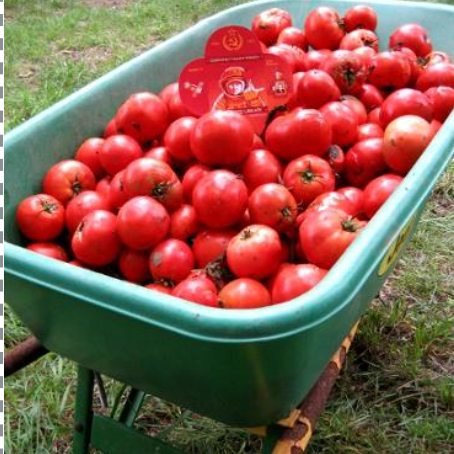 Since we are a seed library farm, not a large commercial seed producer, we do things much the same way as home gardeners, just in larger batches. We process most of our tomato seeds in the barn (picture 5 gallon buckets of goopy seeds instead of quart jars) and bring the tasty parts up to our kitchen. That's because tomatoes are one of the veggies where seed saving and good eating go hand in hand. While the seeds are fermenting and smelling up the barn, we're making tomato basil cucumber salads for lunch--or, more often, canning or freezing them for later eating.Last year we canned about 80 quarts of tomatoes--stewed, sauce, and salsa. We’re just finishing the last of them while the next season's fresh tomatoes start coming in.
Since we are a seed library farm, not a large commercial seed producer, we do things much the same way as home gardeners, just in larger batches. We process most of our tomato seeds in the barn (picture 5 gallon buckets of goopy seeds instead of quart jars) and bring the tasty parts up to our kitchen. That's because tomatoes are one of the veggies where seed saving and good eating go hand in hand. While the seeds are fermenting and smelling up the barn, we're making tomato basil cucumber salads for lunch--or, more often, canning or freezing them for later eating.Last year we canned about 80 quarts of tomatoes--stewed, sauce, and salsa. We’re just finishing the last of them while the next season's fresh tomatoes start coming in.
Here are our instructions for how to save tomato seeds from your garden. Remember, no matter how you choose to save them, save seeds from your healthiest looking plants.
Saving Seeds from Heirloom Tomatoes
Saving seeds from heirloom tomatoes is a great first step in producing your own garden seeds. You usually need only sacrifice a few fruits to save enough seeds for next year’s plants—and even these few fruits will yield a portion of tomato for eating or cooking.
PLAN
To save seeds that will grow true to type, be sure to select from heirloom or open-pollinated varieties. Seed saved from hybrid tomatoes will not grow true but will produce offspring with a wide range of dissimilar characteristics.
OBSERVE
Start by eyeing a few of your best-looking fruits as they mature on the vine. It’s best to save seeds from your top performers, so you may even want to sneak a little little bite first to make sure you're saving seeds from your best-tasting tomatoes.
PREPARE
Once you’ve selected the fruit from which you’ll save seed, gather together a glass jar, a strainer, an unwaxed paper plate, and an air-tight container.
 PROCESS
PROCESS
1. Let your tomatoes ripen on the vine or even start to go a little soft.
2. Pick the tomatoes from different plants—but don’t eat them yet!
3. Slice the tomatoes in quarters and squeeze the pulp and seeds into the jar. Make sure to keep varieties separate and labeled.
4. Set aside the fleshy portions of the tomatoes for cooking—you don’t need them for seed-saving.
5. Add to the jar the same amount of water as pulp.
6. Let the pulp/water mixture sit for three to five days or until a smelly layer of white mold has formed on the surface. Don’t eat this stuff.
7. Skim off the mold and rinse seeds in strainer until clean.
8. Place seeds on paper plate, label, and let air dry. If the weather is humid and stagnant, provide a fan to help with air circulation. For small batches I usually let the seeds dry right in the strainer.
9. Store dry seeds in a labeled, air-tight container in a cool, dark place.
10. Plant your seeds next season!
A NOTE ON CROSS POLLINATION
There are different opinions as to how often different varieties of tomatoes cross with each other. In general, regular leaf tomatoes cross less and potato leaf and cherry varieties cross more. The recommended isolation distance between varieties is 25 to 50 feet. However, many home gardeners successfully collect seed in tight spaces. In fact, we've saved seeds from plants that were right next to each other (in our trials and development gardens) and found a high consistency and almost non-existent cross-pollination occurrence.) Give it a try!





